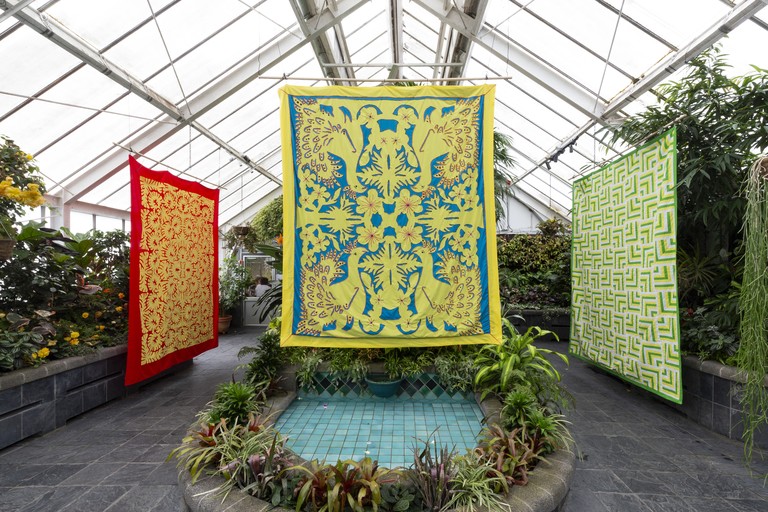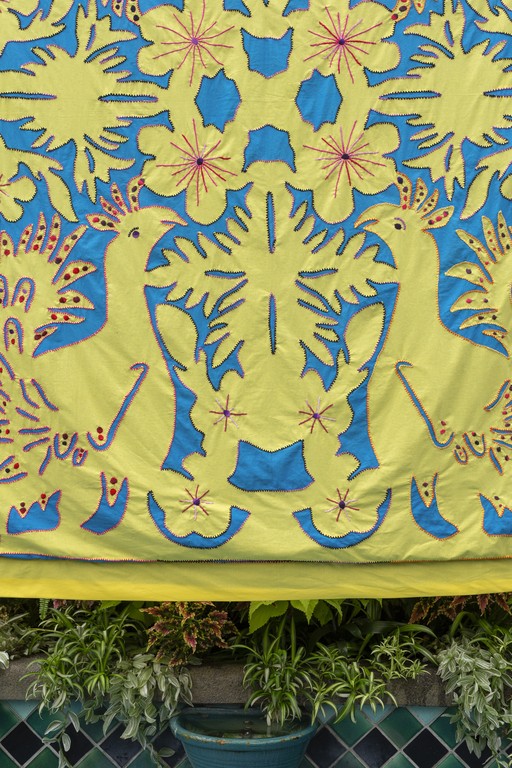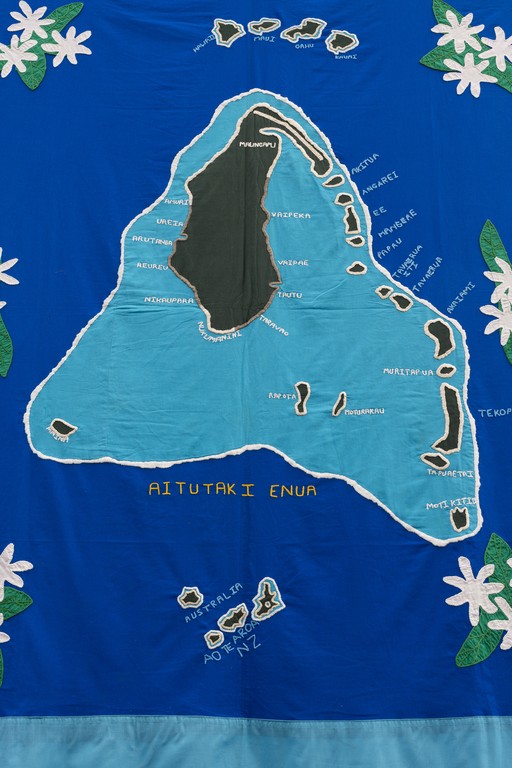Exhibition Essays
Tuku Aroha
March 2025
Tuku Aroha
Brooke Pou
Tīpurepure Au Va’ine is an exhibition featuring the works of the Porirua based Cook Islands sewing group of the same name, accompanied by a soundscape by Jamie Berry. Through tīvaevae and audio, these artists pay homage to whakapapa, imagery and oro (sound) reminiscent of their homelands. This offsite exhibition, curated by Tehani Buchanan, honours the many Cook Islanders who have found Begonia House to be a place of connection and inspiration while living in the diaspora.

Tīpurepure Au Va'ine installation view. Courtesy of Cheska Brown.
The site that the Begonia House stands on was once a forest of rimu, tōtara and mataī. Prior to colonisation, Te Ātiawa were kaitiaki of the nearby Pipitea and Kumutoto pā and they utilised the whenua here for food and resources. When land surveyors from the New Zealand Company arrived in Te Whanganui-a-Tara they quickly drafted plans on top of kāinga Māori. The plans for the Wellington Town Belt included a Botanic Garden, which was established in 1868. The whenua was transformed into a place “typical of British colonial botanic gardens”1 for the purposes of “acclimatising and examining the economic potential of plants…the study and collection of indigenous flora and the establishment of exotic plants…and for the public as a place of recreation and enjoyment”.2
Throughout the years, the Garden has undergone many changes. The 1960 opening of the Begonia House coincided with the migration of a small but “proportionally significant”3 number of Cook Islanders to Aotearoa. For some Cook Islanders, the Begonia House is a place to connect with each other and their homeland by viewing the tropical flowers and plants that remind them of home. A few members of Tīpurepure Au Va’ine have been visiting for decades, drawing inspiration from these flowers for their tīvaevae, some of which are displayed in this exhibition.

Tīpurepure Au Va'ine, installation view. Courtesy of Cheska Brown.
The artworks on show are various forms of tīvaevae, a kind of quilt made collaboratively and used not on beds, but during hair cutting ceremonies, birthdays, weddings and funerals. As gifts, they “articulate connections among kin.”4 It has been said that tīvaevae originates with the early missionaries introducing embroidery to people of the moana, who took to the artform instantly due to their preexisting appreciation of textiles. Prior to European arrival in the moana, tapa was the ultimate mark of status. Its ceremonial use reflects that of tīvaevae today. In the nineteenth century, people of the Cook Islands combined their new sewing skills with their already incredibly refined eye for composition and design, resulting in tīvaevae—loosely translated as “to patch.”5 The tīvaevae in Tīpurepure Au Va’ine exemplify the centuries of knowledge, adaptation, and aroha inherent in the artform.

Te Tua o Te Rai Akaiti Samuel (Aitutaki, Rakahanga, Manihiki), Moara'ora'o (Peacock), Tīvaevae Tātaura, 2023, detail. Courtesy of Cheska Brown.
URU, a soundscape by Jamie Berry, features birdsong from native manu of both the Cook Islands and Aotearoa. Berry specialises in crafting audio rooted in whakapapa by using natural elements—apparent in how the vocalisations of these manu blend seamlessly with the lush foliage of Begonia House. This audio evokes the long held ties between the Cook Islands and Aotearoa. The track incorporates taonga pūoro in moments of darkness and is balanced by the bright tīvaevae in the space; a match made in Cook Islands/Māori heaven. Interestingly, manu patterns on tīvaevae are considered by some to be unlucky. Te Tua o Te Rai Akaiti Samuel (Aitutaki, Rakahanga, Manihiki) disregards this in Moara’ora’o (Peacock), Tīvaevae Tātaura, 2023. The hand embroidered vibrant yellow appliqué depicts flora and peacocks, surrounded by a blue background. According to Tehani Buchanan, “to mama Akaiti, animals are what makes her tīvaevae unique.”6

Te Tua o Te Rai Akaiti Samuel (Aitutaki, Rakahanga, Manihiki), Aitutaki Map, Tīvaevae Tātaura, 1995, installation view. Courtesy of Cheska Brown.
While our tūpuna observed the migratory patterns of birds on their great ocean voyages, Samuel presents the more recent migration her grandmother undertook from Hawai’i to Aitutaki in Aitutaki Map, Tīvaevae Tātaura, 1995. It is reminiscent of Tupaia’s map from 1769. Tupaia, a Tahitian tane who was an integral source of mātauranga on Captain Cook’s first voyage, drew a map of over seventy islands in Te Moana nui-a-Kiwa. Embellished with place names in the Tahitian language, the map is known for its ‘unusual’ layout, as it does not depict “a bird’s-eye view of the curved world stretched onto a two-dimensional plane”7 in the manner that European maps do, but rather “a canoe’s-eye view, a perspective that shifts depending on where you start from”.8 To really see the story behind Aitutaki Map, you must shift your perspective of cartography from the dominant European one to an appreciation of Indigenous knowledge systems. Samuel situates Aitutaki in the centre of this tīvaevae map. Traditional names of the atolls and villages have been hand embroidered and Aitutaki’s airport runway is a notably long white line at the top of the island. Size and distance are distorted—the world's largest body of water does not appear as we know it and Australia has shrunk to be comically disproportionate. Beyond the narrative of her grandmother, Samuel records the homeplaces of her mokopuna across the moana, with tiare Māori, the gardenia (and national flower of the Cook Islands), used as a framing device.

Te Tua o Te Rai Akaiti Samuel (Aitutaki, Rakahanga, Manihiki), Aitutaki Map, Tīvaevae Tātaura, 1995, detail. Courtesy of Cheska Brown.
Other tīvaevae in this exhibition include representations of riri (lillies), matirita (chrysanthemum), okete (orchid), iku nikau (coconut fronds), kuru (breadfruit tree) and patu (four walls of a wooden house). Each artwork is the physical manifestation of centuries of knowledge, painstakingly detailed work, and above all, the bonds between Tīpurepure Au Va’ine—these colourful women.
-
1.
Wellington City Council, Botanic Gardens of Wellington Management Plan, 2014, 122. https://archivesonline.wcc.govt.nz/nodes/view/882223.
-
2.
Ibid.
-
3.
Phillipa Mein Smith, A Concise History of New Zealand, (Cambridge: Cambridge University Press, 2013), 192.
-
4.
Ruha Fifita, James Moale, Lana Lopesi, Ruth McDougall and Emily Nguyen-Hunt (eds), “Tungane Broadbent” in SIS: Pacific Art 1980-2023 (Brisbane: Queensland Art Gallery | Gallery of Modern Art, 2023), 149.
-
5.
Ioana Gordon-Smith, “Anything But Shy: Exhibitions of Tīvaevae” in Pacific Arts Aotearoa, edited by Lana Lopesi (Tāmaki Makaurau: Penguin, 2023), 94.
-
6.
Conversation with Tehani Buchanan, 12 March 2025.
-
7.
Christy Gelling, “Reading a Pacific navigator’s mysterious map may require a shift in perspective” in Knowable Magazine, 2021. DOI: 10.1146/knowable-122321-2.
-
8.
Ibid.
